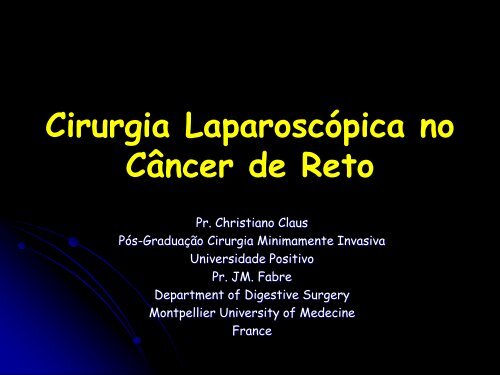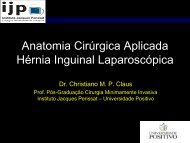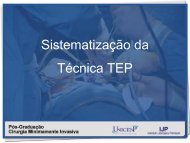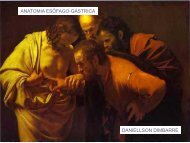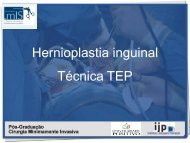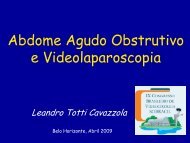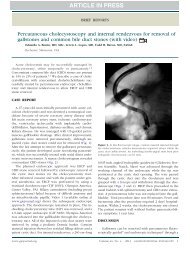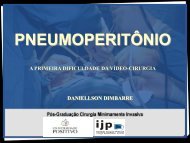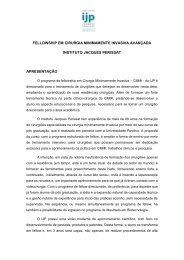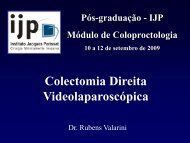Neoplasia do Reto X Laparoscopia - IJP
Neoplasia do Reto X Laparoscopia - IJP
Neoplasia do Reto X Laparoscopia - IJP
You also want an ePaper? Increase the reach of your titles
YUMPU automatically turns print PDFs into web optimized ePapers that Google loves.
Cirurgia Laparoscópica no<br />
Câncer de <strong>Reto</strong><br />
Pr. Christiano Claus<br />
Pós-Graduação Cirurgia Minimamente Invasiva<br />
Universidade Positivo<br />
Pr. JM. Fabre<br />
Department of Digestive Surgery<br />
Montpellier University of Medecine<br />
France
French Clinical Guidelines<br />
2005<br />
1. Avaliaçao pré-operatória<br />
2. Indicações de tratamento neoadjuvante<br />
3. Conceito de TME<br />
4. Importância da margem circunferencial<br />
5. Princípios de Cirurgia Oncológica<br />
6. The quality of excision assessment<br />
7. Pontos técnicos chaves<br />
8. Resulta<strong>do</strong>s da cirurgia laparoscópica
1. Avliação pre-operatória para definir<br />
terapia adjuvante<br />
1. Extensão local da <strong>do</strong>ença<br />
• Exame clínico<br />
• Proctoscopia rígida para tumores <strong>do</strong> terço médio ou superior<br />
• Ultrssonografia en<strong>do</strong>rretal : T (grade B)<br />
• RMI para T3-T4 tumor (margem circunferencial)<br />
• Nenhum exame pré-op pode acuradamente predizer estadio N<br />
2. Disseminação a distância<br />
• CT scan (pulmão, ab<strong>do</strong>men e pelve)<br />
• Ou ultrassonografia e radiografia de tórax<br />
• Colonoscopia
2. Indicações de terapia neoadjuvante<br />
• Radioterapia pré-operatória<br />
• Diminuir a recidiva local estadios II e III (T3,T4 +/-<br />
assumi<strong>do</strong> N+) (Grau A)<br />
• Sem efeitos adversos precoces<br />
• Aumenta a chance de cirurgia conserva<strong>do</strong>ras<br />
• Radio-quimioterapia<br />
• Aumenta <strong>do</strong>wnsizing, <strong>do</strong>wn-staging <strong>do</strong>s tumores<br />
• Diminui a taxa de recidiva local quan<strong>do</strong> comparada a<br />
radioterapia sozinha nos tumores T3,T4<br />
• Porem não melhora a sobrevida livre e sobrevida global<br />
• Aumenta os efeitos tóxicos da radioterapia<br />
neoadjuvante<br />
Colorectal Cancer Cooperative group. Lancet 2001;Sauer Ret al. N Engl J Med<br />
2004; Gerard GP et al. J Clin Oncol 2006; Bosset JF et al. N Engl J Med 2006
2. Indicações de terapia pré-operatória<br />
• Cancer de reto médio e inferior (< 10 cm da margem anal)<br />
• Sim: para T3, T4 +/- N+ (Grau A)<br />
• Não: para T1, T2 N0<br />
• Discutível (se segurança ressecção completa R0 margem sergura)<br />
• T1, T2 N+<br />
• T3 N0 com disseminção limitada no mesorreto<br />
• Cancer de reto superior (10
2. Algoritimo radioterapia pré-operatória<br />
• Evidente tumor ressecável<br />
• Def: tumor móvel, margem circunferencial > 1mm RMI<br />
• Opções<br />
• Radioterapia curto-prazo (5 X 5 Gy 5 dias) segui<strong>do</strong> de cirurgia<br />
imediata próxima semana<br />
• Radioterapia convencional (45 Gy 5 semanas) segui<strong>do</strong> de<br />
cirurgia após 5-6 semanas<br />
• Tumor volumoso, margem circumferencial < 1mm<br />
RMI<br />
• Radioquimioterapia proposta segui<strong>do</strong> de cirurgia após<br />
5-6 semanas
Opções terapêuticas pré-operatórias<br />
para câncer de reto baixo e médio<br />
En<strong>do</strong>rectal Ultrasonography<br />
T1-T2 N0<br />
Surgery<br />
T3-T4 +/- N+<br />
RMI<br />
Circumferential margin > 1 mm<br />
Circumferential margin 1 mm<br />
Preop Radiotherapy<br />
Surgery<br />
Preop Radiochemotherapy<br />
Surgery
Swedish Rectal Cancer Trial:<br />
Benefïcios a longo prazo da radioterapia na taxa de<br />
sobrevida e recidiva local<br />
1987-1990. 5 X 5 Gy in week + surgery vs surgery alone; No systematic TME<br />
Median follow up 13 years<br />
Radiottt and surgery<br />
Surgery alone<br />
N 583 585<br />
Local recurrence according to stage<br />
Stage I<br />
Stage II<br />
Stage III<br />
Local recurrence according tumor height<br />
< 5cm<br />
6-10 cm<br />
>11 cm<br />
Distant metastases<br />
Stage I<br />
Stage II<br />
Stage III<br />
9%<br />
4.5%<br />
6%<br />
23%<br />
10%<br />
9%<br />
8%<br />
34%<br />
14%<br />
29%<br />
55%<br />
26%*<br />
14%*<br />
22%*<br />
46%*<br />
27%*<br />
26%*<br />
12%<br />
34%<br />
13%<br />
36%<br />
57%<br />
Overall survival rate 38% 30%*<br />
Cancer-specific survival rate 72% 62%*<br />
Folkesson J, Birgisson Helgi et al. JCO 2005
3. Excisão Total <strong>do</strong> Mesoreto<br />
• O conceito de TME foi introduzi<strong>do</strong> por Heald (1982) a<br />
• Recidiva local em 5 anos: < 5% e sobrevida em 5 anos: 80%<br />
• Taxa de deiscência anastomótica<br />
• 11% de fístula anastmótica em 219 pacientes (clínica)<br />
• 6.4% adicional fístula assintomática (estu<strong>do</strong>s contrasta<strong>do</strong>s)<br />
• O impacto da aplicação TME tem si<strong>do</strong> demonstra<strong>do</strong> pr<br />
diversos grupos na Europa e USA<br />
• Compiladas series com mais 10,000 pacientes<br />
• A taxa de recidiva local após cirurgia apenas foi 18.5%<br />
• 8.5% Dukes' A; 16.3% Dukes' B; 28.6% Dukes' C<br />
• LR foi 7.1% em 1,033 pacientes submeti<strong>do</strong>s TME<br />
• Efeito <strong>do</strong> cirurgião no tratamento <strong>do</strong> cancer de reto, a taxa de<br />
recidiva local varia de 5% a 30%<br />
Heald RJ et al. Br J Surg 1982; McCall Int J Colorectal Dis 1995
3. Excisão Total <strong>do</strong> Mesoreto<br />
• Análise de 1411 patients<br />
• Estu<strong>do</strong>s comparativos:<br />
TME X Cirurgia convencional<br />
• Ressecção radical , St II & III , 12 cm MA<br />
TME<br />
CS<br />
• sobrevida 5 anos 62-75% 42-44%<br />
• recidiva local 4-9% 32-35%<br />
Havenga K & al. Eur J Surg Oncol 1999; 25: 368-74.
Radioterapia pre-operatória combinada TME.<br />
Dutch Colorectal Cancer Group.<br />
• 1805 CR : 897 RT + TME / 908 TME<br />
• Cirurgia : 30% terço inferior => 30% APR<br />
• Sobrevida global : 85% / 81.8% p:0.84<br />
• Recidiva local: 2.4% / 8.2% p:0.001<br />
N Engl J Med 2001; 345: 638-46.
4. Margem Circunferencial<br />
• Dutch Colorectal Cancer Group estu<strong>do</strong><br />
ran<strong>do</strong>miza<strong>do</strong><br />
• 656 pacientes no grupo « cirurgia com TME apenas »<br />
• Seguimento medio: 35 meses<br />
• Definição de margem positiva<br />
• Presenca de célula tumoral ou linfon<strong>do</strong> positivo < 1 mm da<br />
margem<br />
• Resulta<strong>do</strong>s<br />
• Taxa de margem positiva: 18.3%<br />
• Margem < ou = 1 mm: LR: 16.4% M: 37.6%<br />
• 1 mm < Margem < 2 mm: LR: 14.9% M: 21%<br />
• Margem > 2 mm: LR: 5.8% M:<br />
Nagtegaal ID. Am J Surg Pathol 2002
Radiotherapy <strong>do</strong>es not compensate for positive resection margins in<br />
rectal cancer patients: report of a multicenter ran<strong>do</strong>mized trial.<br />
• Radioterapia pré-operatória diminui significantemente a taxa de recidiva local<br />
• apenas quan<strong>do</strong> a margem circunferencial são > 2mm ou entre 1 e 2 mm<br />
• Radioterapia pré-operatória não muda a taxa de recidiva local em casos de em<br />
casos de margem circunferencial positiva (< 1mm)<br />
5.8%<br />
14%<br />
0.9%<br />
0%<br />
16.4%<br />
3.3%<br />
0%<br />
13.1%
Radiotherapy <strong>do</strong>es not compensate for positive resection<br />
margins in rectal cancer patients: report of a<br />
multicenter ran<strong>do</strong>mized trial.<br />
• Radioterapia pós-operatória não diminui a taxa de recidiva local após<br />
ressecção retal com TME quan<strong>do</strong> as margens circunferenciais são<br />
positivas ( < 1mm)<br />
Marijnen CA et al. Int J Radiat Oncol Biol Phys 2003
5. Princípios de Cirurgia Oncológica no<br />
Câncer de <strong>Reto</strong><br />
• Princípios Founded<br />
• R0 ressecção<br />
• Excisão <strong>do</strong> mesorreto (grade B)<br />
• Total para cancer de reto terço médio e inferior<br />
• Parcial (pelo menos 5 cm abaixo da borda inferior <strong>do</strong> tumor) no câncer de<br />
terço superior<br />
• Preservação <strong>do</strong> plexo autonômico quan<strong>do</strong> possível<br />
• Dissecção anteriormente a fáscia Denonvilliers’ quan<strong>do</strong> tumor anterior<br />
• Não linfadenectomia sistemática na cadeia ilíaca (grade B)<br />
• Estoma temporario após TME el anastomose retal baixa (grade C)<br />
• Princípios Unfounded<br />
• Ligadura primeiro e alta<br />
• Exclusão en<strong>do</strong>luminal<br />
• Técnica No Touch<br />
• Ooforectomia profilática (grade B)
5. Princípios de Cirurgia Oncológica<br />
• Cirurgia conserva<strong>do</strong>ra<br />
no Câncer de <strong>Reto</strong><br />
• Quan<strong>do</strong> possível resecção com margem distal ≥ 1cm (grade B)<br />
• Possível com ressecção inter-esfinteriana<br />
• Ressecção ab<strong>do</strong>minoperineal<br />
• Se margem de ressecção distal for menor 1cm<br />
• Se disseminação direta da parede pélvica e/ou canal anal<br />
• Não é recomenda<strong>do</strong> mudar a estratégia cirúrgica<br />
planejada após <strong>do</strong>wnstaging com tratamento préoperatório<br />
exceto em estu<strong>do</strong>s controla<strong>do</strong>s.
6. Quality of excision assessment<br />
• Macroscopic assessment of resection: R0/R2<br />
• Mesorreto completo (fascia própria intacta)<br />
• Subcompleta (pequena injúria 2 cm)<br />
• Medida da margem distal de ressecção (peça fresh)<br />
• Avaliação microscópica<br />
• Margem distal, margem circunferencial<br />
• Linfono<strong>do</strong>s (mínimmo 12)<br />
• Ressecção é considerada como paliativa se a margem<br />
circunferencial < 1 mm (R1)
7. Melhora <strong>do</strong>s resulta<strong>do</strong>s funcionais<br />
e Qualidade de Vida<br />
• Reservatório colônico em J<br />
• 5-6 cm comprimento<br />
• Cólon não diverticular<br />
• Opções para pelve estreita<br />
• Coloplastia pouch<br />
• Anastomose términoi-lateral<br />
• Quan<strong>do</strong> 5 cm de reto podem ser<br />
preserva<strong>do</strong>s, pouch colônico não<br />
é necessário<br />
• Disfunção sexual e bexiga<br />
• Preservação nervo-autonômico
8. Indicações para cirurgia laparoscópica<br />
• «Pequeno volume» tumor (T4 excluso)<br />
• Pacientes não-obesos<br />
• Condições intra-operatórias apropriadas<br />
• Perfeita localização <strong>do</strong> tumor (lower edge)<br />
• Tatuagem<br />
• Exame clínico<br />
• <strong>Reto</strong>scopia intra-operatória<br />
• Excisão apropriada <strong>do</strong> mesorreto<br />
• Correta transecção retal<br />
• Grampea<strong>do</strong>r ou trans-anal<br />
• Cirurgião treina<strong>do</strong>
8. Procedimentos laparoscópicos<br />
• Ressecção ab<strong>do</strong>minoperineal<br />
• Peça removida através da incisão perianal<br />
• Colostomia colocada no local de trocárter<br />
• Ressecçao anterior<br />
• Dissecção meticulosa <strong>do</strong> mesorreto<br />
preservan<strong>do</strong> nervos<br />
• Limitações<br />
• Falta de sensação táctil<br />
• Grampea<strong>do</strong>res laparoscópicos para ressecção baixa
8. Justificavas para conversão<br />
• Under evaluated tumors<br />
• Más condições anatômicas<br />
• Impossibilidade de transecção distal <strong>do</strong> reto<br />
• Hemorragia pélvica<br />
• Aderências pélvicas<br />
Tumores baixos e volumosos<br />
Hartley DCR 01 , Poulin SE 02 , Yamamoto DCR 02, Quah BJS 02
Espaço retal lateral<br />
Erectile nerves
Espaço pré-retal
Espaço retro-retal
Espaço retro-retal
Laparo cirurgia de CR : Morbidade<br />
German Observatory de cirurgia laparoscópica CR<br />
380 pacientes<br />
• APR (n: 149)<br />
• Mortalidade : 2%<br />
• Morbidade : 36%<br />
• Perineum wound healing:25%<br />
• AR (n: 231)<br />
• Mortalidade : 1%<br />
• Morbidade : 38%<br />
• Fístula Anastomótica : 14%<br />
• Anastomose > 10 cm: 10% F / < 10 cm: 18%<br />
Scheidbach SE 2002 – Hartley DCR 01
Cirurgia Laparoscópia Versus Aberta para<br />
Câncer de <strong>Reto</strong><br />
• CLASSIC trial: UK, Lancet 2005<br />
• « Impaired short-term outcomes after assisted anterior resection<br />
<strong>do</strong> not justify its routine use »<br />
• Conversão alta (morbidade maior em pacientes com conversão)<br />
• CRM positiva 12% vs 6% (aberta)<br />
• Meta-análise de resulta<strong>do</strong>s curto-prazo<br />
• Feng Gao: Int J Colorectal Dis 2006<br />
• 11 estu<strong>do</strong>s: 285 in Lap e 358 in Open<br />
• Sem diferença parâmetros oncológicos<br />
• Menor taxa de morbidade, maior tempo operatório<br />
• Aziz O: Ann Surg Oncol 2006<br />
• 20 estu<strong>do</strong>s:(1993 -2004); 2071 pacientes: 909 Lap (44%) vs 1162 (56%)<br />
aberta<br />
• Maior tempo operatório<br />
• Shorter LOS, retorno precoce movimentos intestinais,<br />
• Menor infecção de ferida<br />
• Sem diferença nos parâmetros oncológicos<br />
• Menor tempo para funcionamento <strong>do</strong> estoma
Lap vs Aberta TME para cancer de reto<br />
Cochrane database 2006<br />
• Estu<strong>do</strong>s publica<strong>do</strong>s entre 1990 – 2005<br />
• 48 / 80 estu<strong>do</strong>s inclui<strong>do</strong>s (4224 patients)<br />
• 3 level 1B ( individual RCT)<br />
• Leung . Ann Surg 2000<br />
• Leung . Lancet 2004<br />
• Zhou . Surg En<strong>do</strong>sc 2004<br />
• 12 level 2B (individual estu<strong>do</strong> cohort)<br />
• 5 level 3B ( individual estu<strong>do</strong> caso-controle homogêneo)<br />
• 28 level 4 (cohort pobre qualidade and série de caso)<br />
• 48 studies<br />
• 38 prospectivo, 3 retrospectivo, 7 unknown<br />
• Critério de exclusão<br />
• T4 tumor, tumor recurrence, câncer de cólon sincrônico ou metacrônico,<br />
<strong>do</strong>ença metastática, cirurgia de emergência, obstrução intestinal ou<br />
perfuração, CI para cx laparoscópica
Lap vs Open TME for rectal cancer<br />
Cochrane data base 2006<br />
Studies N 1B 2B 3B 4<br />
Survival 16 1 7 1 7<br />
3 years 92%<br />
5 years 75.3 % vs 78.3% 67-88% OS<br />
63-75% DFS<br />
62.5-92%<br />
Local recurrence 31 1 9 4 17<br />
6.6 % vs 4.1%<br />
FU: 52 vs 49m<br />
3.75%-6.8%<br />
FU: 16-45.7m<br />
0-6% 0-24.1%<br />
Mortality 37 3 13 2 19<br />
2% vs 1%<br />
0% vs 0%<br />
0-2.5% 0% 0-25% §<br />
Morbidity 36 3 9 4 20<br />
6.1-29% vs 12.4-35%<br />
6.1 vs 12.4%*<br />
Anastomotic leakage 29 2 9 2 16<br />
OS= Overall survival; DFS= Disease free survival<br />
0.5-1.2% 3-17% ND 0-25%<br />
* Significant difference; Zhou Zg et al. Surg En<strong>do</strong>sc 2004
Lap vs Open TME for rectal cancer<br />
Cochrane data base 2006<br />
Studies N 1B 2B 3B 4<br />
Conversion rate 36 1 12 4 19<br />
23.2% 0-18.2% 0-10% 0-33%<br />
Duration of surgery 38 3 11 4 20<br />
Longer 2/3* 138-267 min Longer 1/4* Longer 6/10*<br />
Blood loss 17 3 3 1 10<br />
Less 2/3* 56-456 ml 250 vs1000 ml* Less 3/10<br />
Transfusion 10 1 4 1 4<br />
6 vs12% (NS) 1-6% 1.2 vs 2.4%* 2-25%<br />
Surgical margins 16 0 2 2 12<br />
- ND ND ND<br />
Lymph node 32 1 9 4 18<br />
11.1vs12.1 6-25 ND Less 1/18<br />
Hospital stay 39 3 9 4 23<br />
Less 2/3 * Less 1/9* Less 3/4* 5-18.3 d in Lap<br />
5.5-25 d in Op<br />
ND= no difference
Lap vs Open TME for rectal cancer<br />
Cochrane data base 2006<br />
Studies N 1B 2B 3B 4<br />
Gastrointestinal recovery 29 3 6 4 16<br />
Sooner 1/3<br />
4.2 vs 4.9 d*<br />
2 - 4.9 d Sooner 3/4 Sooner 4/10<br />
No diff 2/10<br />
No analysed 4/10<br />
Post op pain score 2 2 0 0 0<br />
5.5 vs 6.25<br />
4.6 vs 6.4 *<br />
Post op analgesia 13 3 2 3 5<br />
No diff 2/3<br />
Less 1/3<br />
- Less 2/3 Less 2/5
Lap vs Open TME for rectal cancer<br />
Cochrane data base 2006<br />
• Limitations<br />
• Only 3 RCT<br />
• only 1 describing exclusively the results of patients with rectal cancer<br />
• The majority of papers are level 4 (58%)<br />
• Comments<br />
• No indication of poorer long-term outcome of LTME<br />
• No indication of higher local recurrence rate of LTME<br />
• No evident difference in morbidity<br />
• Evidence that LTME results in<br />
• an earlier return of normal diet<br />
• Less pain<br />
• Less narcotic use<br />
• Shorter hospital stay<br />
• Pending COLOR 2-trial
Bladder and sexual dysfunction following<br />
laparoscopically assisted and conventional open<br />
mesorectal resection for cancer.<br />
• 170 KR drawn from a prospective trial for KCR (250)<br />
• 111 living => 80 responses (40 / 40)<br />
• Paired Group ( Lap / Conv )<br />
• Urinary sequelae : 2 vs 0 NS<br />
• Sexual sequelae H : 7/15 vs 1/22 p: 0,004<br />
• No difference in female<br />
CCl:<br />
Laparoscopic Resection result in more sexual sequelae<br />
in men, especially in the case of lower and voluminous<br />
tumours… !<br />
Quah HM & al. Br J Surg 2002
Bladder and sexual function following resection for<br />
rectal cancer in CLASSIC Trial<br />
• CLASSIC Trial: 794 patients<br />
• 347 eligible for the study. 247 filled questionnaires (I-PSS, IIEF,<br />
FSFI) at 0-12 months (74%) and > 12 months (26%)<br />
• 98 Lap AR, 50 Open AR, 99 Lap Colonic Res (similar compliances)<br />
Lap AR Open AR Lap Col R<br />
N<br />
74 AR<br />
20APR<br />
34 AR<br />
12 APR<br />
99<br />
TME 80% 62%<br />
Conversion 34% 12%<br />
Normal bladder function 65% 65% 79%<br />
Sexual activity<br />
Severe change in male<br />
Severe change in female<br />
41%<br />
25%<br />
23%<br />
18%<br />
4%<br />
8%<br />
Jayne DG et al. Br J Surg 2006
Bladder and sexual function following resection for<br />
rectal cancer in CLASSIC Trial.<br />
• Bladder function<br />
• Worse immediately after surgery but returned to baseline<br />
levels<br />
• No differences between lap and Open<br />
• Sexual activity<br />
• Male<br />
• More problem in erectile and ejaculatory function<br />
• Independent with time of questionnaire (+/-1 year)<br />
• Increased severity with lenght of follow up<br />
• Female<br />
• No significant diference between lap and open surgery<br />
• Factors predictors of poor postop function<br />
• Conversion to open surgery<br />
• Performance of TME rather than PME<br />
Jayne DG et al. Br J Surg 2006
Ressecção laparoscópica pacientes com câncer<br />
colo-retal: Resulta<strong>do</strong>s e custo-benefício<br />
• RCT : 83 Lap vs 85 Aberta<br />
• Quimioradioterapia neoadjuvante no estadio T3<br />
• TME câncer de reto médio e baixo<br />
• Seguimento médio 53.6m<br />
Lap (83) Open (85)<br />
Mean Operative time (min)* 262 209<br />
Mean blood loss (ml)* 213 396<br />
Blood transfusion (%)* 7.2 28.6<br />
Mean LOS (d)* 10 13.6<br />
Post op complications (%) 2.4 10.6<br />
QOL<br />
Better at 1 year<br />
Local recurrence at 3 years (%) 4 5.2<br />
Sem diferença na sobrevida global 5-anos e sobrevida livre-<strong>do</strong>ença qq. estadio<br />
The saving caused by both shorter LOS and lower postop morbidity rate<br />
covered approximately 80% of the Operative Room extra charge caused by<br />
the laparoscopic technique
Conclusões<br />
• Cirurgia laparoscópica para câncer de reto<br />
• Não deve mudar a aplicação da terapia neoadjuvante<br />
• Devem aplicadas as regras de cirurgia oncológica<br />
• Deve ser realizada por cirurgiões experientes<br />
• Must be assessed with specific ran<strong>do</strong>mized trial<br />
• Deve demonstrar pelo menos resulta<strong>do</strong>s similares aos da<br />
cirurgia convencional
Resulta<strong>do</strong>s longo-prazo TME laparoscópica<br />
Tsang<br />
2006<br />
Bretagnol<br />
2005<br />
Lechaux<br />
2005<br />
Morino<br />
2005<br />
Bärlehner<br />
2005<br />
Dulucq<br />
2005<br />
N 105 144 179 98 194 142<br />
Years 99-04 00-03 92-03 94-02 9é-03 92-04<br />
Conversion 2 20 (14%) 39 (16%) 18 (18%) 2 (1%)<br />
Microscopic positive margin 2 (1.9%) 9 (6%)<br />
Mortality 0% 1 (1%) 1 (1%) 0%<br />
Re-surgery 6 (5.7%) 6 (6.1%) 22(11%)<br />
Erectile dysfunction 13.6%<br />
Mean Follow up 26.9 m 18 m 76 m 46.9 m<br />
5-year cancer-specific surv<br />
81.3%<br />
89%<br />
80% 76.9%<br />
Dukes’A<br />
100%<br />
85% (s I)<br />
100%<br />
Dukes’ B<br />
94.1%<br />
70% (s II)<br />
94.4%<br />
Dukes’ C<br />
65.2%<br />
63% (s III)<br />
66.6%<br />
5-year disease-free surv 64.4% 77% 65.4% 76.9% 67%<br />
Local recurrence 5 (4.8%) 2 (1.4%) 3.2% 6 (4.1%) 6.8%<br />
Tsang. Ann Surg 2006; Morino Surg En<strong>do</strong>s 2005; Leroy Surg En<strong>do</strong>s 2004; Dulucq Surg En<strong>do</strong>s 2005;<br />
Lechaux Ann Chir 2005; Bretagnol 2005; Bârlehner Surg En<strong>do</strong>s 2005
Sobrevida após cirurgia laparoscópica<br />
Year N AR / APR Mort<br />
.<br />
Morb.<br />
Loc.<br />
recur<br />
Port<br />
recur<br />
Followup<br />
Surv.<br />
Yamamoto 2002 70 93%/ 7% 0% 18.6% 2.9% 0% 17.5 100%<br />
Poulin 2002 80 65%/35% 2.5% 19% 3.7% 0% 23 65.1%<br />
Scheidbach 2002 380 39%/61% 2% 37.6% 0% 0% 14 100%<br />
Feliciotti 2003 81 74%/26% 0% 21% 0% 43.8 62.5%<br />
Leroy 2003 102 85%/15% 2% 27% 6% 0% 36 65% (5y)<br />
Morino 2003 100 100%/- 2% 12% 4.2% 1.4% 45.7 74%(5y)<br />
Leung 2004 203 100%/- 2.5% 23.2% 6.6% 0% 52.7 76%(5y)<br />
Bretagnol 2005 144 100%/- 1% 34% 1.4% 0% 18 89%<br />
Lechaux 2005 179 154/23 1.5% 29% 3.9% 0.8% 76 78%(5y)<br />
Bärlehner 2005 194 91%/8% 0% 20% 4.1% 0.5% 46.1 78.9(5y)<br />
Dulucq 2005 142 100%/- 6.8% 0% 57 67%(5y)<br />
Tsang 2006 105 100%/- 0% 24% 4.8% 0% 26.9 81%(5y)
Mean follow-up (mo)<br />
Author Resection type Year Design Lap Open Conversion (%) Lap Open<br />
Tate AR 1993 PNR 11 14 0 – –<br />
Darzi APR 1995 PNR 12 16 0 – –<br />
Goh AR 1997 PNR 20 20 0 8 10<br />
Leung AR 1997 PNR 50 50 16 32.8 39.1<br />
Seow-Choen APR 1997 PNR 16 11 0 33 12<br />
Ramos APR 1997 PNR 18 18 10 18 22<br />
Iroatulam APR 1998 R 7 7 – – –<br />
Fleshman APR 1999 R 33 152 – 20.5 27.5<br />
Schwandner AR and APR 1999 PNR 32 32 0 33.2 31.0<br />
Leung APR 2000 PNR 25 34 8 30.1 28.3<br />
Hartley AR and APR 2001 PNR 21 22 – 38 –<br />
Baker APR 2002 R 28 61 25 35.6 30.8<br />
Quah AR and APR 2002 PR 86 84 12 3 3<br />
Anthuber AR and APR 2003 PNR 101 334 11 – –<br />
Araujo APR 2003 PR 13 15 0 47.2 47.2<br />
Feliciotti AR and APR 2003 PNR 81 43 12 43.8 43.8<br />
Hu AR 2003 PNR 20 25 0 8–17 8–17<br />
Vorob’ev AR 2003 PNR 64 78 25 36 36<br />
Wu AR and APR 2004 PNR 18 18 0 – –<br />
Guillou AR and APR 2005 PR 253 128 34 3 3
Paramètres N d’études No Lap / Open OR/WMD P<br />
Paramètres opératoires Lap / Open Lap / Open<br />
Temps opératoire 12 324 /467 – 40.18 S<br />
Marge circonférentielle positive 8 359 / 424 9.5% / 10.8% .93 NS<br />
No. De ganglions prélevés 17 550 / 925 – −.87 NS<br />
Complications postop précoces<br />
Mortalité 12 425 / 838 3.1%, / 3.2% .6 NS<br />
Hémorragie 7 422 / 428 5.7%, / 4.4% 1.24 NS<br />
Fistule anastomotique 8 533 / 627 8.4%, / 6.7% 1.28 NS<br />
Complications périnéales 5 101 / 235 2.3% / 16.2% 1.03 NS<br />
Sepsis pariétal 12 496 / 388 8.9% / 10.1% .84 NS<br />
Infection respiratoire 10 448 / 333 7.4% / 4.5% 1.47 NS<br />
Iléus 7 156 / 167 5.1% / 8.4% .62 NS<br />
Thrombose,Embolie pulmonaire 4 330 / 328 6% / 1.9% .58 NS<br />
Rétention urinaire 9 223 / 358 7.7% / 10.3% .91 NS<br />
Réhabilitation Postopératoire<br />
Délai de reprise d’une stomie 5 96 / 215 3.2d vs 4.4d −1.52 S<br />
Délai de reprise du transit 5 98 / 99 3d vs 4d −.72 S<br />
Délai de reprise des boissons 5 108 / 222 – −1.57 NS<br />
Délai d’alimentation solide 9 269 / 409 – −.92 S<br />
Temps d’analgésie IV 6 132 /137 – −.44 NS<br />
Durée moyenne de séjour 16 476 / 892 – −2.67 S<br />
Complications tardives<br />
Occlusion intestinale 5 114 / 233 1.8%, / 5.6% .40 NS<br />
Eventration 6 144 / 269 4.2% / 3% 1.28 NS
Laparoscopic Versus Open Surgery for Rectal<br />
Cancer. APR . Meta-Analysis<br />
Outcome of interest<br />
No<br />
of studies<br />
No<br />
Outcomes by<br />
group<br />
Operative outcomes Lap / Open Lap / Open<br />
OR/WMD a<br />
Operative time 5 99 / 222 – 35.94 S<br />
Positive radial margins 4 96 / 257 7.3% / 12.5% .69 NS<br />
No. lymph nodes harvested 8 152 / 314 – −.05 NS<br />
Early postoperative complications<br />
Perianal wound complications 5 101 / 235 22.8%, / 16.2% 1.03 NS<br />
Wound infection 4 71 / 79 0% / 13.9% .15 S<br />
Urinary retention 6 108 / 242 13.9% / 14% .92 NS<br />
Postoperative recovery<br />
Time to stomal function 3 56 / 170 – −1.76 S<br />
Time to feeding solids 4 92 / 215 – −1.52 S<br />
Requirement for parenteral analgesia* 3 59 / 63 – −.63 S<br />
Length of stay 7 139 / 299 −4.74 S<br />
Late complications<br />
Bowel obstruction 3 61 / 179 3.3% / 6.1% .44 NS<br />
P
Bladder and sexual dysfunction after<br />
rectal resection<br />
• Before TME<br />
• 10-30% of postop urinary dysfunction<br />
• 40-60% of postop sexual dysfunction<br />
• After TME<br />
• 0-12%<br />
• 10-35%<br />
• After laparoscopic surgery?


